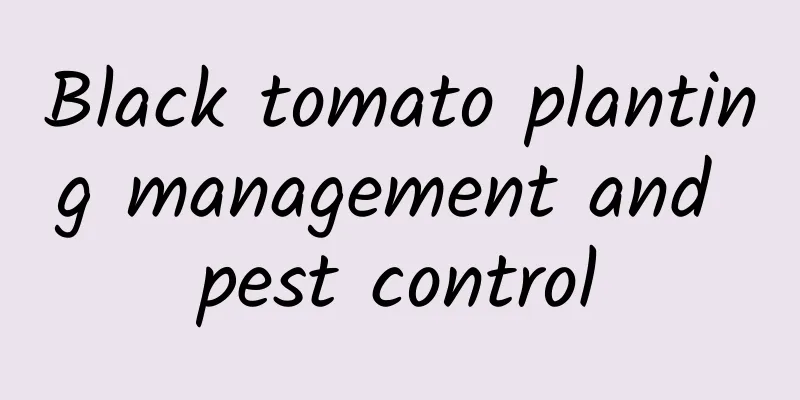Black tomato planting management and pest control

|
Tomato management is very important, so let me tell you about the management of black tomatoes: 1. Fertilizer and fertilization:Nitrogen fertilizer is the most effective fertilizer for black tomatoes, and potassium fertilizer is also indispensable. The amount of nitrogen fertilizer and potassium fertilizer is multiple of that of ordinary tomatoes, which is conducive to the production of melanin. When insufficient fertilizer is applied, the plants grow weak and thin, and the yield is low; when excessive fertilizer is applied, the stems are thick and the leaves are large, which is easy to cause leggy growth, flower drop, calcium deficiency and disease, and the fruits are relatively flat and deformed. Phosphorus fertilizer can promote the development of new roots and increase pollination rate, which is more important in the early growth period. Black tomatoes are degraded in quality and prone to diseases and pests due to lack of calcium (lime) and boron, so attention should be paid to reasonable application. It should be applied with reference to soil fertility, cultivation methods, fertilizer sources and prices, local fertilization experience, etc. Generally, organic fertilizer is used as the main fertilizer, and more than 2,000 kilograms of compost are used per mu. The ratio of nitrogen: phosphorus: potassium fertilizer is 22:10:19. Compost is mainly applied deep and early. In order to increase the quality of black tomatoes and quickly increase the sugar content, 100 kilograms of vegetable cake fertilizer can be applied per mu. When black tomatoes are cultivated, the basal fertilizer is applied deep into the soil by digging trenches. The first topdressing is applied after planting (about 10 days after planting), and the circumference is 10 cm. The second time is applied before the support is erected, and the soil is then cultivated. The third time is applied 20 to 30 days after the second time, and the edge of the furrow is applied. Water after topdressing. 2. Other management:Before the first and second topdressing, weeding should be carried out. By the late growth stage, the roots have covered the soil surface and it is not suitable to till the soil. Herbicides can be used to weed the black tomato field. Please refer to the use of herbicides in vegetable gardens. Although tomatoes are relatively drought-resistant, their growth is inhibited when they are too dry. The soil should not be dry after planting, but it should not be watered too much after growing, otherwise it is easy to cause leggy growth and soil-borne diseases. When it rains, attention should be paid to drainage to avoid water accumulation in the furrows. Applying grass on the furrow surface during the high temperature period, rainy season and dry period can prevent excessive soil temperature, soil erosion, soil surface compaction and soil moisture evaporation. When pruning, choose sunny days for work, and deformed fruits and fruits with diseases and insect pests should be picked as soon as possible. If conditions permit, the whole furrow surface should be covered with double-color or black mulch for the best effect. 3. Pest and disease controlThe main diseases of black tomatoes include navel rot, bacterial wilt, late blight, leaf spot, powdery mildew, virus disease, etc.; the main insect pests include root knot nematodes, tomato armyworms, aphids, eggplant borers, etc. Physiological diseases mainly include abnormal terminal buds or symmetrical and parallel occurrence of two buds caused by boron deficiency. Pests and diseases and physiological diseases mainly implement the principle of "prevention first, comprehensive prevention and control". Effective prevention and control should be carried out according to local production conditions. 4. Harvesting, grading and packagingBlack tomatoes begin to bloom 20 to 30 days after planting, and begin to mature 30 to 35 days after flowering. In warm weather, they bloom and mature earlier, and the melanin changes color the fastest. In cold weather, they bloom and mature later, and the color changes slowly. |
<<: Papaya pudding ingredients and methods
>>: Black tomato planting technology
Recommend
How is the Bolivian Embassy in China? Reviews and website information of the Bolivian Embassy in China
What is the website of the Embassy of Bolivia in C...
How to make Yinhua porridge
Do you still remember how to make honeysuckle porr...
The efficacy and function of green grape peel
Green grapes are a type of grape. They are sweet ...
How is AOL Sports News? AOL Sports News Review and Website Information
What is AOL Sports News? SportingNews is a famous ...
What are the hazards of L-carnitine? What are the contraindications of taking L-carnitine?
L-carnitine is a new type of health product. It i...
Top 10 Low-Sugar Fruits List What are the Low-Sugar Fruits?
As people's living standards have improved, h...
How is the Caribbean Hurricane Network? Caribbean Hurricane Network Reviews and Website Information
What is the Caribbean Hurricane Network? The Carib...
How is Merck? Merck reviews and website information
What is the website of Merck? Merck Sharp & Do...
How to make sweet potato porridge
How to make sweet potato porridge? I believe many ...
What are the nutritional values of salmon and the benefits of eating salmon
Salmon is a well-known aquatic food. It has tende...
How to make delicious pig skin
Pig skin is a food ingredient that many people do...
The benefits of eating crystal pears
Crystal pear is a kind of fruit pear. It is said ...
The benefits of eating small persimmons and soft dates
The small persimmon soft date is the fruit of the...
Ingredients and steps for sea cucumber, yellow rice and straw mushroom porridge
Straw mushrooms are very delicious food. They are...
The nutritional value of durian and the effects and functions of eating durian
I believe that everyone has not eaten durian, but...









